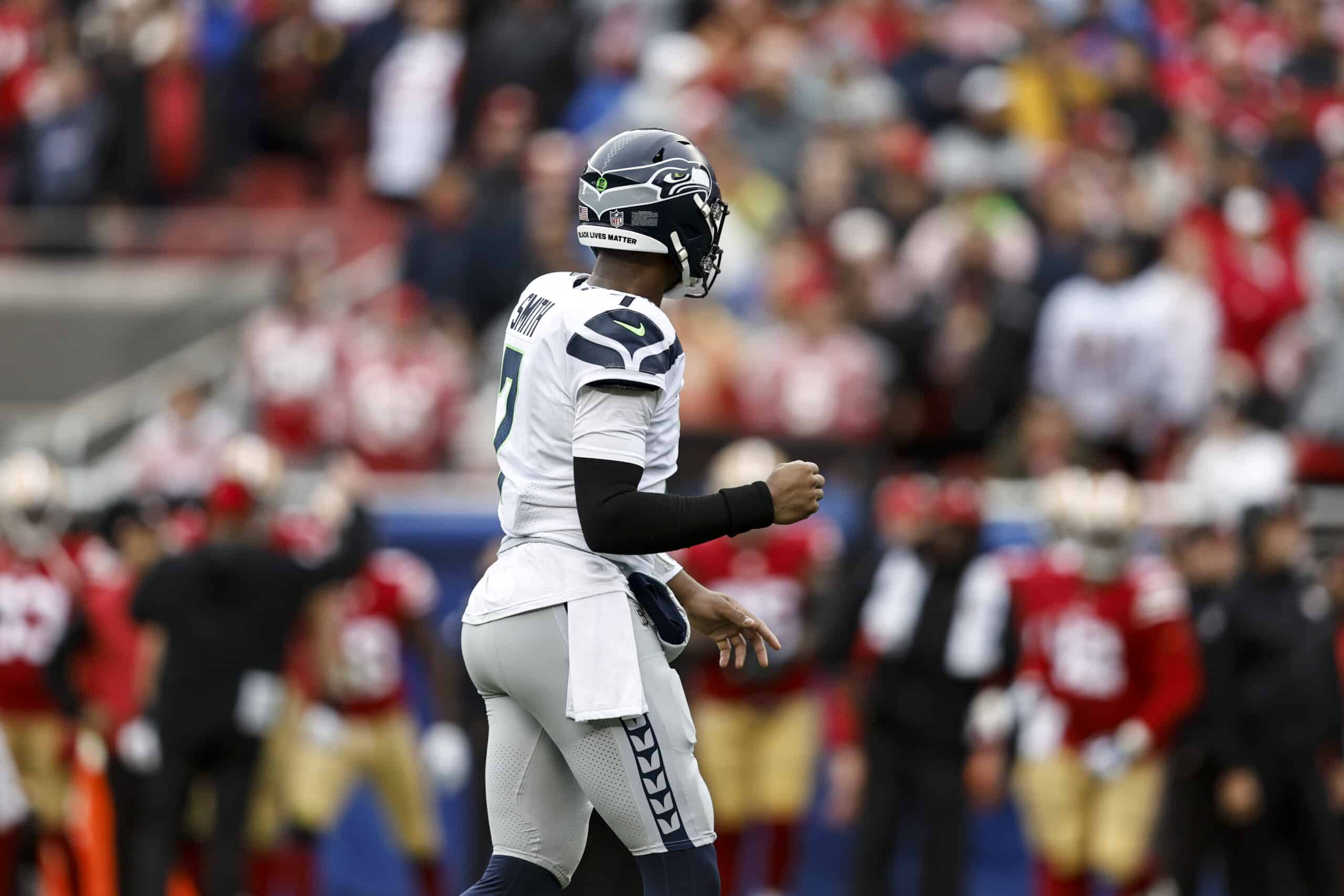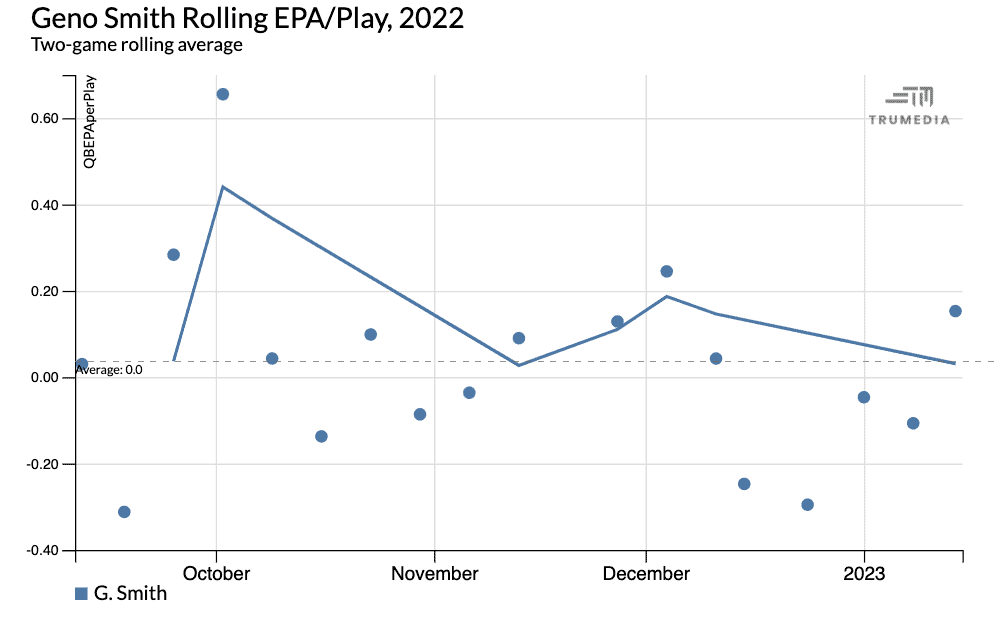There was always going to be a deal done between the Seattle Seahawks and Geno Smith. While there have been contentious negotiations across the league between teams and impending free agent quarterbacks, there was never a sign of danger between Seattle and Smith.
The question was always what the contract would look like. We got the answer just under 24 hours before the franchise tag deadline. Smith and the Seahawks agreed to a three-year/$105 million contract with up to $51 million through the first calendar year. That contract pays Smith $35 million per year, though the frontloaded nature should give the Seahawks an early out if needed — especially given Seattle’s precedent of only fully guaranteeing the first year of a contract.
Smith’s $105 million cash through three years just surpasses the contract given to Derek Carr by the Saints and currently ranks ninth among quarterbacks, according to Over The Cap.
The Geno Smith story is a fun one — a former second-round pick who bounced around the league as a backup and finally got a chance to start as a 32-year-old after the Russell Wilson trade. Smith led the league in completion percentage and completion percentage over expectation, according to Next Gen Stats, and won Comeback Player of the Year.
After an incredibly hot start, Smith only finished the season 21st in EPA per play. That figure overshadows the good Smith did throughout the season but there was a drop in production over the second half of the year, including a four-game streak with negative EPA to end the regular season with two of his three worst games in that final stretch.
From a process standpoint, there wasn’t much difference from Smith before and after Seattle’s bye. He was throwing passes at about the same depth while they were completed less often. However, there wasn’t a drop in accuracy. Before the bye, Smith had the third-lowest rate of inaccurate passes according to TruMedia. After the bye, Smith also had the third-lowest rate of inaccurate passes.
The biggest negative impact was how Smith handled pressure. His negative EPA more than doubled under pressure after the season while he faced pressure a bit more often.
Geno Smith Pre-Bye vs Post-Bye, 2022
data per TruMedia
| Weeks | EPA/Play | Comp% | aDOT | YPA | Pressure EPA/P | Blitz EPA/P | Clean EPA/P |
|---|---|---|---|---|---|---|---|
| 1-10 | 0.07 | 72.8% | 7.52 | 7.8 | -0.21 | -0.11 | 0.17 |
| 12+ | -0.04 | 66.0% | 7.62 | 7.1 | -0.47 | -0.14 | 0.15 |
Seattle had two rookie tackles who started off the season strong but had some struggles through the latter stretch of the season. The Seahawks still finished seventh in Pass Block Win Rate and there could be more reinforcements coming with upgrades to the interior this offseason.
This is where the contract has its biggest impact. It’s not just that the Seahawks now have Smith locked up — the focus should now be on what this next version of the roster will be. It starts with figuring out what slipped in the second half of the season and how to manage it in 2023.
Smith was one of the league’s best passers throwing down the field, ranked fourth in EPA per play on throws of 11 or more air yards. There were times late in the season when defenses were able to protect against the deep pass and force Smith to hold onto the ball, which either created more pressure or forced a less efficient short pass.
Adding another legitimate wide receiver to a group that includes DK Metcalf and Tyler Lockett could help open things up. Smith was at his best in 11 personnel during the 2022 season. He averaged 0.01 EPA per play from 11 and -0.04 EPA per play from 12 with a second tight end on the field.
Using 11 helped open some things up for the Seahawks and it kept an extra defender out of the box in the run game, which also avoided one of Smith’s biggest splits when accounting for the safety alignment in coverage. Smith was one of the league’s best passers against two-high coverages (0.13 EPA per play, seventh-best) but struggled against single-high (-0.04 EPA per play, 22nd).
From 11 personnel, the middle of the field was open (two-high) on 47.3% of Smith’s dropbacks. From 12, that was 44.5% and teams went harder with the middle of the field closed against 12 personnel — 54% of the time.
Seattle was more efficient running the ball from 11 — 0.01 EPA per play and 5.7 yards per carry compared to -0.09 EPA per play and 4.5 yards per carry from 12. The Seahawks saw a light box in the run game 64% of the time from 11 and just 5.6% from 12.
The Seahawks’ 20th pick could be used to fix this. There are a few wide receivers who could go in this range, such as Jordan Addison or Jaxon Smith-Njigba. Or Seattle could lean into a more dynamic 12 personnel look and add more of a receiving threat in a deep class of tight ends that could include Notre Dame’s Michael Mayer or Utah’s Dalton Kincaid to give another option when defenses come up to play the run.
Either way, another passing game weapon could help sustain the passing offense and allow the Seahawks to be more versatile in offensive formations.
But the biggest question might be how the Seahawks view the future of the team with the fifth overall pick. Pete Carroll and John Schneider were in great moods at the combine when reflecting on the 2022 season and looking ahead. Schnider even called the draft capital “cool,” considering the Seahawks have not picked this high in the draft during his tenure as general manager.
With quarterbacks expected to go early, the Seahawks could find an impact defensive player on the board to help a young defense that showed promise but ranked 25th in EPA per play last season.
Yet there is still the chance of a quarterback. Neither Carroll nor Schnieder downplayed the possibility when speaking to the media in Indianapolis. Both stressed the importance of not getting locked into a need. In a best player available situation, it would not be a stretch to imagine a quarterback would top Seattle’s draft board in the top five — especially if it’s a player such as Flordia’s Anthony Richardson, who could develop some behind Smith while the Seahawks could still use the 20th pick to get another first-round talent for the team.
The Smith extension is a well-deserved reward for a quarterback who played well and keeps the Seahawks in the mix for the playoff race in 2023. The frontloaded money and likely just first-year guarantee also leaves the door open for the Seahawks to start shaping the next era as early as this offseason. How Seattle decides to approach that could be one of the most fascinating decisions of the offseason.

















